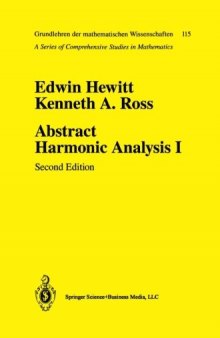 جزییات کتاب
جزییات کتاب
When we acce pted th ekindinvitationof Prof. Dr. F. K. Scnxmrrto write a monographon abstract harmonic analysis for the Grundlehren. der Maihemaiischen Wissenscha/ten series,weintendedto writeall that wecouldfindoutaboutthesubjectin a textof about 600printedpages. We intended thatour book should be accessi ble tobeginners,and we hoped to makeit usefulto specialists as well. These aims proved to be mutually inconsistent. Hencethe presentvolume comprises onl y half of theprojectedwork. Itgives all ofthe structure oftopological groups neededfor harmonic analysisas it is known to u s; it treats integration on locallycompact groups in detail;it contains an introductionto the theory of group representati ons. In the second volume we will treat harmonicanalysisoncompactgroupsand locallycompactAbeliangroups, in considerable et d ail. Thebook is basedon courses given by E. HEWITT at the University of Washington and the University of Uppsala,althoughnaturallythe material of these courses has been en ormously expanded to meet the needsof a formal monograph. Like the. other treatments of harmonic analysisthathaveappeared since 1940,the book is a linealdescendant of A. WEIL'S fundamentaltreatise (WElL [4J)1. The debtof all workers in the field to WEIL'S work is wellknown and enormous. We havealso borrowed freely from LOOMIS'S treatmentof the subject (LoolIIS[2 J), from NAIMARK [1J,and most especially from PONTRYA GIN [7]. In our exposition ofthestructur e of locally compact Abelian groups and of the PONTRYA GIN-VA N KAM PEN dualitytheorem,wehave beenstrongly influenced byPONTRYA GIN'S treatment. We hope to havejustified the writing of yet anothertreatiseon abstractharmonicanalysis by taking up recentwork, by writingoutthedetailsofeveryimportantconstruction andtheorem,andby including a largenumberof concrete ex amplesand factsnotavailablein other textbooks
 درباره نویسنده
درباره نویسنده

ادوین هاوارد آرمسترانگ (به انگلیسی: Edwin Howard Armstrong) (زادهٔ ۱۸ دسامبر ۱۸۹۰ – درگذشتهٔ ۳۱ ژانویه ۱۹۵۴) مهندس برق و ابداعکنندهٔ مدولاسیون فرکانس رادیویی بود.
 دانلود کتاب
دانلود کتاب
 جزییات کتاب
جزییات کتاب
 درباره نویسنده
درباره نویسنده
 ادوین هاوارد آرمسترانگ (به انگلیسی: Edwin Howard Armstrong) (زادهٔ ۱۸ دسامبر ۱۸۹۰ – درگذشتهٔ ۳۱ ژانویه ۱۹۵۴) مهندس برق و ابداعکنندهٔ مدولاسیون فرکانس رادیویی بود.
ادوین هاوارد آرمسترانگ (به انگلیسی: Edwin Howard Armstrong) (زادهٔ ۱۸ دسامبر ۱۸۹۰ – درگذشتهٔ ۳۱ ژانویه ۱۹۵۴) مهندس برق و ابداعکنندهٔ مدولاسیون فرکانس رادیویی بود. 








 این کتاب رو مطالعه کردید؟ نظر شما چیست؟
این کتاب رو مطالعه کردید؟ نظر شما چیست؟
